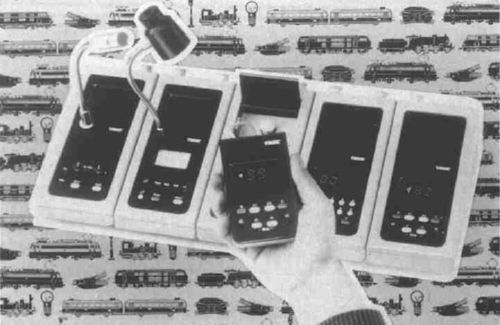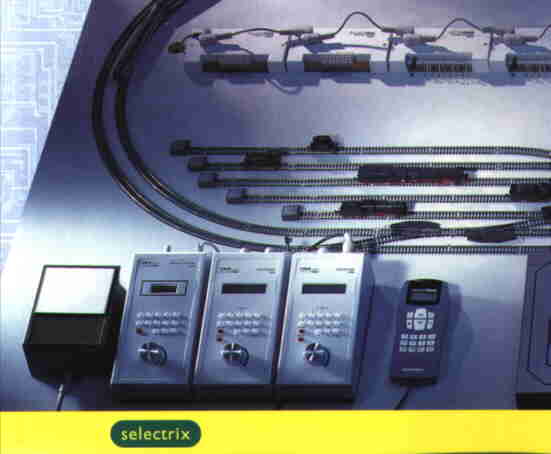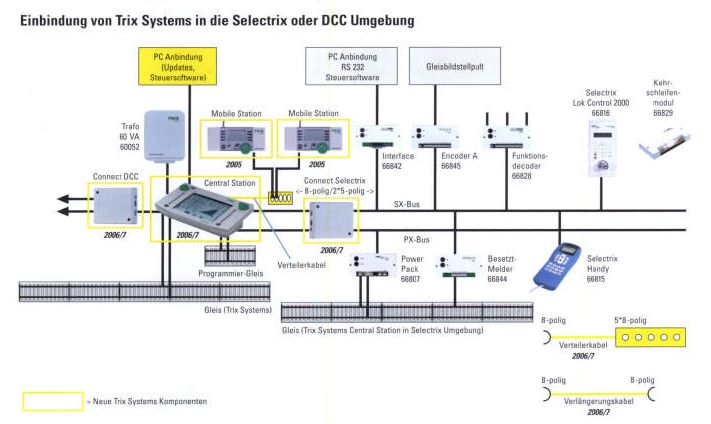![]()
![]() digital command control
digital command control
> main > model > control > selectrix
In 1980, a small German electronics
engineering company, Döhler
& Haass, developed a digital command control system for model
railways and offered it to the many German and Austrian model
railway manufacturers to include it in their range. Only Trix was
interested, but it took another 3 years before Selectrix became
available to the public. Selectrix was introduced at the 1982 Nuremberg
Toy Fair, where a prototype was shown. Right from the start there were
decoders available that were small enough to build into N-scale
locomotives, including very small 4-wheeled engines. The first
Selectrix equipment looked a bit different from the units offered
nowadays, but all components are compatible. This brings me to the big
advantage of Selectrix: ALL available components are compatible and
work with each other, regardless of manufacturer. There are a few
limitations, mainly in the range of available decoder addresses.
Adresses from 1 to
99 work on all Selectrix systems.
Selectrix took a great leap forward with the introduction of the second series of components in 1992. New, even smaller, decoders became available and the control devices were upgraded. The new system offered a cheap starter kit which can control only 9 locos, but with addition of a second controller, the whole adress range becomes available. A new feature is that Selectrix can run NMRA DCC decoder fitted locos, although the NMRA mode is limited to even short adress numbers and offers only 14 speed steps.
At the moment most new developments in Selectrix come from other manufacturers like Rautenhaus and Müt (Digirail). Both offer command stations, loco and accessory decoders, handheld and desktop controllers and miscellenous hardware.
 Selectrix as it was
announced in 1982 (photo: Railhobby)
Selectrix as it was
announced in 1982 (photo: Railhobby)
Selectrix features
Selectrix has 112 adresses available, these must be divided between locomotives, accessory decoders and feedback decoders, it is recommended to use loco decoders adresses in the 1-99 range. Do not use adress '0'. With a 'translator' module you can add a second databus for adding extra accessory and feedback decoders. All loco decoders have 31 speed steps, back EMF feedback speed control to ensure smooth running, directional lighting and one momentary extra function ('horn'). One accessory decoder can drive 8 turnouts or signals, or 16 momentary outputs (for uncouplers). A feedback decoder can sense 16 block sections. Selectrix has a unique method of transferring data, with two databuses, one for data and a second bus to feed boosters. Both buses use 5 wire cables, fitted with 5-pole DIN plugs. The land-based devices ( boosters, accessory decoders, feedback modules) have matching sockets. The cables can be purchased or when yo have a little soldering experience you can make them yourselves. The buses can be split, ringed etc. in any configuration and the maximum cable length is well over 50 metres per bus.
 A
typical Selectrix digital command control
setup. From left to right: Transformer, Central Control 2000, 2x
Lok-Control 2000, Control Handy. The boxes 'in the loop' are
accessory decoders and track circuits. (photo: Trix)
A
typical Selectrix digital command control
setup. From left to right: Transformer, Central Control 2000, 2x
Lok-Control 2000, Control Handy. The boxes 'in the loop' are
accessory decoders and track circuits. (photo: Trix)
Recent developments
A trend seems to develop that Trix will be leaving the Selectrix system and therefore other manufacturers will fill in the gap left by Trix. At the moment most new products are introduced by Müt and Rautenhaus. At the Nürnberg 2005 Toy Fair, Trix has introduced the Trix Systems range, starting with the 'Mobile Control' unit, a handheld unit that plugs into a trackside booster unit. The Trix Systems range will support both DCC and Selectrix standards. Special 'Connect' adapter boxes will be introduced to connect your Trix Systems main unit to an existing Selectrix and/or DCC equipped layout. From now on Selectrix is gradually phased out by Trix and new Selectrix developments are most likely to expect from smaller manufacturers like Rautenhaus and Müt.
Trix Systems
Trix Systems is the name for the new Digital Command Controls system by Trix. The design of the equipment is the same as their 'Märklin Systems' counterparts, only the knobs are green instead of red. The system design is different as are the command protocols supported. The image below shows how a full system could be built up, also showing the 'Connect' options.

As you can see, the 'Central Stations'
unit could be connected to both a DCC system (manufacturer unknown) and
a Selectrix systems. All Triz Systems equipment supports both DCC
(NMRA) and Selectrix protocols, so old Selectrix-decoder equipped locos
ran run without limitations. More details are to follow when more
information is available.
Manufacturers who offer Selectrix compatible components:
Trix, now owned by Märklin showed a
prototype in 1982, products became available from about 1985 onwards.
At the moment the future of Trix Selectrix products range is unclear,
the NMRA DCC based 'Trix Systems' range will take
over gradually. German language.
Müt offers a complete range, with the Multi-Control (cat. no. 2004) being the most important item. It is a full-featured command station, includes 3 Amps booster, programming unit, large LCD display, buttons and control knob on top of the unit.
Rautenhaus offers accesory decoders, reverse loop modules etc. New is a controller with 4 speed control knobs and 4 small LCD displays. A command station is now available, the 4-knob controller is needed to enter settings and control locos. A new command station completes the range.
MDVR offers Müt, Rautenhaus and Selectrix components.
MTTM offers accesory modules, hand-held loco controllers and control software. Co-operation with Müt. Website includes lots of technical information on the Selectrix system.
Holtermann Modellbahntechnik offers a barcode train identification system which can be connected to a Selectrix system.
Viessmann offers loco and accessory decoders and a booster uit is announced for 2005.
ESU offers the LokPilot Micro, a DCC and Selectrix compatible loco decoder.
Uhlenbrock
offers loco decoders that are DCC, Selectrix and MM compatible.
All of the above links are in the German language!
Pahasoft offers a free control software package. You need to register to have access to all features, but it is still free! (Dutch language)
Jürgen Freiwald offers Railroad&Co., which offers also a wide range of control options, but supports a wider range of systems.
Railware
is rather new. Supports most systems including Selectrix.
Links to induviduals' pages with information on Selectrix, including do-it-yourself projects, in German language:
Heiko Deserno's pages, with information on his layout and decoder fitting information
Günther
Wiencirz's page, information on his
loco conversion projects, including sound-equipped locos.
Frank Keil has information on fitting decoders, his layout and do-it-yourself projects.
Uwe Magnus has many do-it-yourself projects, including 3 differerent hand-held controllers.
Guido H. Brock explains how to fit a decoder plug into your loco, if there is not one fitted by the factory. Not only for Selectrix users!
Acknowledgements:
Much of the information needed to write this article comes from the Internet pages of the different manufacturers, the Fremo website and the MTTM website for many details on the Selectrix system and the many pages set up by individuals.